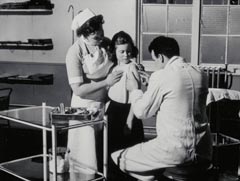Immunisation
Vaccination uptake rates have historically been higher in Scotland than in other parts of the UK. This reflects recognition of the fact that vaccines are among the safest and most successful interventions available for protecting public health.
Children have benefitted most. The advent of the NHS in 1948 increased the ability of public health services to deliver national immunisation programmes. Children are now routinely vaccinated and protected against measles, whooping cough, Haemophilus influenzae type b (Hib), meningococcal C infection C (MenC), mumps, polio, diphtheria, tetanus and rubella.
Their impact has been substantial. For example in 1939 the year vaccination against diphtheria was introduced, there were 395 deaths in Scotland; there have been no deaths since 1968.
Uptake rates for immunisation in children remain high. In 2007, the 95 per cent target for immunisation of 2 year olds was exceeded for all vaccines apart from the first dose of MMR where the rate is 92.1 per cent. However in the same year, the uptake of the first dose of MMR by 5 years old is 94.4 per cent just below the World Health Organization target of 95 per cent. This shows that many parents have responded to the controversy over the safety of MMR by delaying the time of vaccination.
Vaccines also protect older people. Every year a concerted effort is made by general practices and community pharmacists to deliver the influenza immunisation programme. It is anticipated that the final vaccination uptake figures for 2007/08 will demonstrate that the target of 70 per cent for the over 65s will have been met once more. However the uptake in adults with conditions which put them at more risk of complications is still not as high as it could be.
Scientific advances have led to safer more effective vaccines. In the 1990s, immunisation programmes were introduced against Meningitis C and Haemophilus influenzae group B infections with great success. In 2006 a vaccine against life-threatening conditions caused by pneumococcal infection was included into the childhood schedule.
In 2007, we saw a reduction of 32 per cent in these diseases in the under-fives compared to the previous four years, a very hopeful sign for the future In September 2008, all girls in second year at secondary school will be routinely offered the human papilloma virus vaccine (HPV) against cervical cancer. And all girls aged between 13 and 17 years at September 2008 will also be offered the vaccine as part of an introductory three-year campaign to ensure widest cover at the outset.
Despite substantial progress, much remains to be done to further reduce disease and suffering. Vaccine scares will not go away. People rightly expect an effective, convenient service which delivers a safe product to protect their health. The NHS needs to meet those expectations and continue building on the successes of the last 60 years so that all Scots can be free from life-threatening infections.
Dr Martin Donaghy
Medical Director, Health Protection Scotland
- Further information
- Health Protection Scotland

